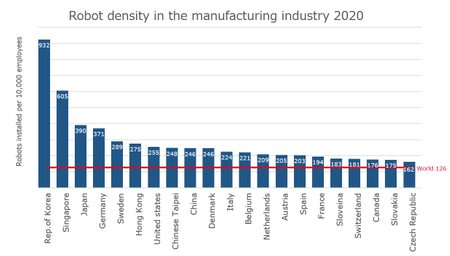As a partner in the age of automation The growing widespread use of industrial robots
The reality of automation
The demand for automation is growing year after year for a variety of reasons, including reducing labor shortages, improving productivity, and responding to ever-changing consumer trends. Industrial robotics is becoming a sought-after automation solution to meet these diverse needs.
This indispensable solution in the “age of automation” is highly versatile and contributes to labor-saving efforts. Nevertheless, there are still many areas where robotics adoption has not progressed. According to International Federation of Robotics (IFR) statistics, global robot density (the number of industrial robots used per 10,000 manufacturing workers) still remains between one to a few percent.
However, the rise of new technologies has made units smaller and lighter, made collaborative robots available, and enabled innovative system integration. These advances have opened up many new areas of application beyond large-scale manufacturing sites.

According to the IFR, International Federation of Robotics, although robot density is increasing every year, the global average is still about 100 units per 10,000 employees. Even the top-ranking countries, Singapore, South Korea, and Japan, have not reached 10%. Robotics adoption is still largely in mass-production and large-scale manufacturing sites within the electronics and automotive industries. (Global robot density statistics from the International Federation of Robotics. (2020 data published in 2021)*1
Benefits of production line automation
Achieve consistent quality
Robots can execute highly precise tasks repeatedly, eliminating quality variations and human error. The improvements in yield rate and productivity by achieving consistent quality are the most common benefits reported by customers who have deployed a robot at their site. In addition, unlike a specialized machine for a specific application, robots can be reprogrammed for product or process changes, increasing manufacturing flexibility.
Solve labor shortages
By deploying robots, manufacturers can free their employees from monotonous, repetitive tasks or harsh work environments. Therefore, they can allocate their workforce to more creative or high-skilled jobs, contributing to work style reformation and resulting in more opportunities for human resources development and company growth. Minimizing the number of workers through automation can also reduce labor costs. Furthermore, in the post-corona era, robots could be the solution to reduce human-to-human contact or respond to a sudden shortage of workers.
Industrial robot deployment case studies
In the last half-century, industrial robots have been deployed mainly in factories for automobiles and semiconductors. However, more companies, regardless of the size, industry, or type of business, have been looking for robotics automation solutions in recent years.
For example, our versatile dual-arm collaborative robot “duAro” can be installed in the space alongside human workers. One of our customers installed it in the corner of their office for a part assembly process for medical robots. The task of inserting two stainless steel pins into an aluminum block the size of a human hand was simple, yet required a high degree of precision as they were medical parts. Bringing in robots to perform this task has achieved zero human errors. By eliminating defects completely, the company has improved its production rate and allowed its employees to engage in more advanced and specialized jobs.
Another end-user deployed a vertical articulated robot to be used with their cardboard box-making machine, automating the packing process from boxing frozen foods to shipping. The burden of employees was substantially reduced. Packing frozen foods into boxes was not an easy task as the foods were cold, heavy, and hard to grip. In addition, the workers performed the task in a cold environment. Bringing a robot in to perform this task improved the work environment. Because this automation eliminated the risk of frozen products coming into contact with body heat, it resulted in more consistent product quality.
There are as many applications of industrial robots as you can imagine. As a partner in the “age of automation” toward a prosperous tomorrow, industrial robots are gaining more attention for their possibilities.
*1: “World Robotics Report 2020” (the International Federation of Robotics)
